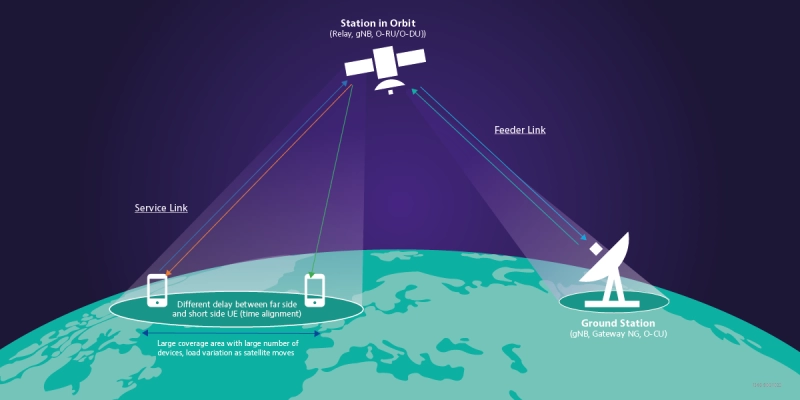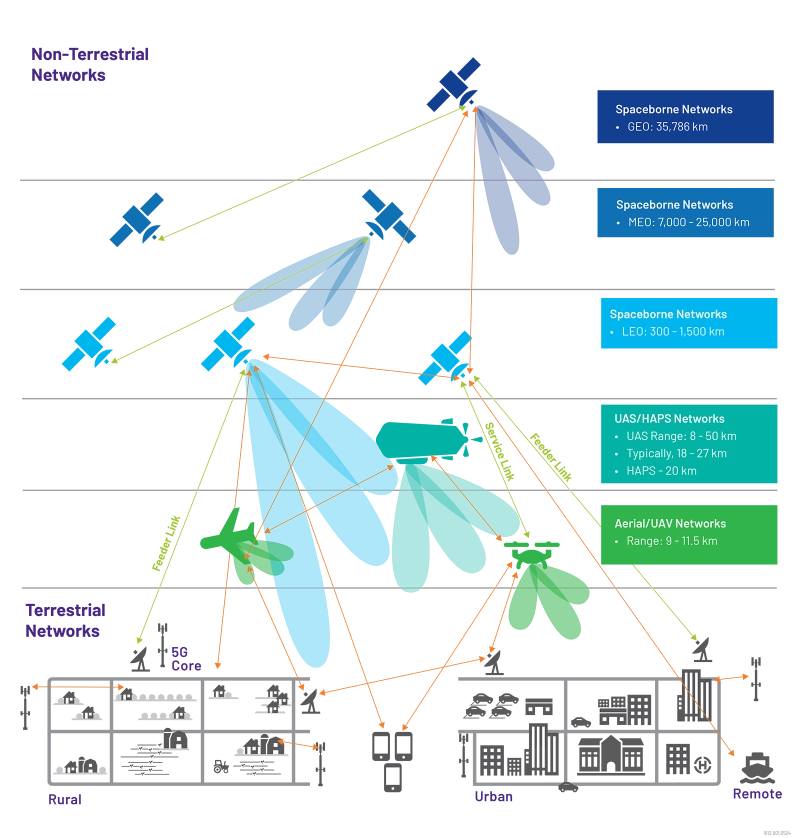What are Non-Terrestrial Networks (NTN)?
Non-terrestrial networks (NTN) are wireless communication systems based above the Earth, utilizing platforms high in the air or satellites in orbit. Constellations of NTN satellites in low earth orbit (300-1,500km), medium earth orbit (10,000-20,000km), and geostationary orbit (36,000 km) combine to deliver uninterrupted, global service. High-altitude platforms (HAPs) and drones are also leveraged for non-terrestrial network communication.

As 5G NTN standards are solidified through the adoption of 3GPP Release 18 and 19, applications ranging from precision agriculture to ships at sea can leverage NTN coverage. Non-terrestrial networks can also provide options for consumers in need of unlimited roaming capabilities, such as aircraft passengers. With more use cases emerging all the time, the global NTN market size is expected to increase from $4 billion to over $23 billion by 2028.
With their unencumbered, aerial vantage point, non-terrestrial networks come with many features and benefits that are not feasible with conventional land-based (terrestrial) networks. The primary advantages of NTNs include:
- Enhanced coverage: The global reach of NTNs enhances coverage by providing 5G and broadband access to more users, especially in underserved or remote areas. The additional bandwidth and capacity of non-terrestrial networks also addresses the requirements of emerging technologies like the internet of things (IoT) and massive machine-type communication (Mmtc) that rely on consistent service over large geographical areas.
- Disaster response: The nearly unlimited reach and resiliency of 5G NTN communication make it a valuable tool for coordinating emergency services or rescue efforts when terrestrial networks are compromised by natural disasters, regional conflicts, and other unpredictable factors.
- Futureproofing: As worldwide 5G service is established, non-terrestrial networks make it easier to scale capacity, either by deploying additional satellites to reinforce existing networks, or deploying entirely new constellations. The ability to quickly expand coverage without acquiring and developing land-based cell sites also makes it easier to address rapid IoT expansion.
- Low latency: Despite contending with spaceborne challenges including delayed Doppler effects produced by satellite movement, extremely large (200km) cell sizes, and continuously changing capacity demands, low earth orbit (LEO) NTNs can still provide low latency service through precise timing and synchronization.
5G wireless requires a combination of enhanced coverage and increased capacity for use cases like enhanced mobile broadband (eMBB), smart factories, and connected health. This makes non-terrestrial networks the perfect 5G complement as coverage and applications expand throughout the world.
- 5G NTN configuration: Rather than deploying more radio transceivers (gNBs) on the ground to meet 5G capacity demands, non-terrestrial networks utilize satellites and other airborne vehicles as radio transceivers to flexibly expand coverage. NTN gateways on the ground relay information between satellites and the 5G core.
- Distributed architecture: The central unit/distributed unit (CU/DU) split is a key architectural feature of distributed 5G networks. Integrating DU functionality onboard the satellite allows the benefits and efficiencies of 5G split architecture and Open RAN to be extended to 5G non-terrestrial networks as well.
- Mobile cell connectivity: 3GPP has defined multi-connectivity use cases, where user equipment (UE) connects to satellites and ground-based terrestrial links simultaneously. Mobile cell connectivity supports seamless handovers, as 5G users leverage extended NTN coverage in remote areas. These capabilities make global 5G service more resilient and flexible.

5G Non-Terrestrial Networks Frequency
Just as constellations at multiple orbit levels are being deployed to address various 5G use cases, multiple frequencies are being leveraged to compensate for the challenging distance and bandwidth requirements of NTNs.
- Frequency range 1 (FR1): Satellite constellations transmitting over frequencies between 410MHz and 7.1GHz provide long range connectivity to mobile phone users and IoT devices. Low FR1 frequencies were the first to be allocated to NTN since they are ideal for rural areas lacking ground-based infrastructure.
- Frequency range 2 (FR2): 3GPP Release 18 expanded available non-terrestrial networks frequencies to include millimeter wave (mmWave) frequencies between 24GHz to 100GHz. All NTN FR2 bands utilize frequency-division duplexing (FDD) technology to compensate for the long roundtrip time.
- Frequency range 3 (FR3): As developers look forward to the next generation of non-terrestrial networks, frequencies between 7.1GHz and 24GHz (FR3) are being considered for additional spectrum. FR3 includes the Ku-band (12-18GHz) already in use for satellite television broadcasts.
5G New Radio NTN
While 5G New Radio (NR) defines the standard air interface for 5G networks, NR NTN describes the sub-set of technology used connect user devices to high-speed 5G services through non-terrestrial networks. Compelling 5G NR NTN use cases include:
- Fixed wireless access (FWA): Satellites in geostationary orbit (GEO) in sync with the Earth’s rotation can provide reliable broadband service to areas where wired internet connections are not practical or possible.
- Ubiquitous roaming: With 5G NR NTN filling in the gaps that once existed between major cities and continents, seamless, uninterrupted access to mobile 5G data and voice service becomes the norm.
- 5G backhaul support: 5G NTN can augment traditional fiber backhaul by transmitting data received from cell towers to NTN gateways. This option is especially useful for backhaul traversing open water or harsh terrain.
Terrestrial 5G networks rely on earth-bound infrastructure including cell towers and fiber cables to deliver low-latency, high-bandwidth service. Non-terrestrial networks excel at providing coverage and resiliency over a wide area without the benefit of extensive ground infrastructure. However, the physical distances traversed by NTN signals make it impossible to provide the ultra-low latency required for 5G applications like robotic surgery and driverless transportation.

The contrast between terrestrial and non-terrestrial networks also makes them complementary, as NTNs avail 5G service to more users while conventional terrestrial networks support densely populated areas and the most challenging use cases. 3GPP continues to address complex handovers, spectrum congestion, dynamic 5G backhaul, and regulatory requirements that must be resolved for terrestrial and non-terrestrial networks to operate harmoniously.
IoT Over Non-Terrestrial Networks
The internet of things (IoT) is a 5G use case with high capacity demands that do not always coincide with low latency requirements. IoT over non-terrestrial networks (NTN-IoT) supports voluminous IoT devices with satellites in GEO and LEO orbits.
- NB-IoT: Narrowband IoT (NB-IoT) is a low power, wide area network (LPWAN) standard developed by 3GPP to address low cost IoT applications with high connection density, such as smart vending machines and livestock tracking. Generous latency requirements make IoT NTN an appropriate technology for this class of service.
- LTE-M: Long-Term Evolution for Machines (LTE-M) is also a LPWAN standard, but it is intended for IoT applications that need cellular connectivity, such as the intermittent communication between machines in smart factories.
Top NTN Deployment Challenges
Despite the undeniable benefits, non-terrestrial networks also introduce new deployment and test challenges, due to the complexity of NTN satellite systems, extremely large cell sizes, low signal to noise ratios (receiver sensitivity issues) and other variables that do not impact their terrestrial cousins. Top non-terrestrial networks deployment challenges include:
- High Cost: NTN satellite constellations are extremely expensive to build, deploy, and maintain. This underscores the value of comprehensive satellite testing and network emulation prior to launch.
- Doppler shifts: Fast moving satellites in low earth orbit experience a Doppler effect that changes signal frequency relative to observers on the ground, while distant satellites in geostationary orbit introduce long delays between uplink and downlink transmissions.
- Environmental concerns: A drawback of global 5G coverage that cannot be avoided yet is the high energy consumption shared by terrestrial networks and NTNs. The potential for unprecedented space debris also raises environmental concerns.
NTN Standardization
All stakeholders in the non-terrestrial networks ecosystem recognize that standardization is among the most pressing short-term challenges for operators, service providers, and satellite network developers. 3GPP Release 17 provided an initial framework for 5G NTN in 2022 by defining non-terrestrial networks platforms and introducing support for NB-IoT and 5G NR NTN. Release 18 added support for additional frequency bands and performance enhancements, while Release 19 will include onboard satellite processing improvements.
NTN Security
The open configuration of non-terrestrial networks increases vulnerability to spoofing, signal jamming, and eavesdropping tactics that threaten 5G security and privacy. The development of secure network protocols, intrusion detection systems, and cryptographic techniques have been prioritized to prevent NTNs from becoming a security liability. Authentication of network elements during handovers is another important key to safeguarding NTN security.
With the advent of 6G just a few years away, non-terrestrial networks will be integral to its success. Along with record-breaking speeds, microsecond latency, and seamless connectivity, unlimited accessibility is a facet of 6G wireless that can only be accomplished through 6G NTN.
- Next-level integration: The integration between terrestrial and non-terrestrial networks will reach a new plateau to deliver the promise of 6G. Satellite constellations working in conjunction with unmanned aerial vehicles (UAV) and moving ground base stations will make up this complex 6G RAN architecture.
- 6G IoT: The internet of things will be redefined by 6G, with more efficient communication protocols, active communication between devices, and extensive geographic coverage making the internet of everything a reality. Non-terrestrial networks are among the backbone technologies that will make this vision a reality.
Unlock unparalleled cellular space connectivity with our industry leading NTN solutions that guarantee stability, reliability, and performance. Explore our NTN solutions today!